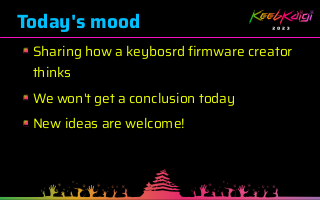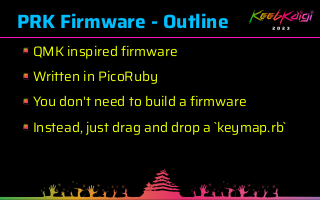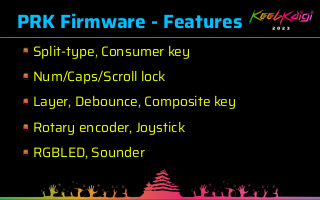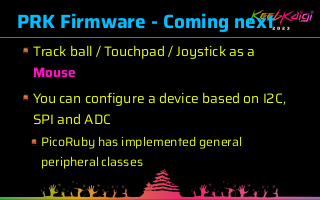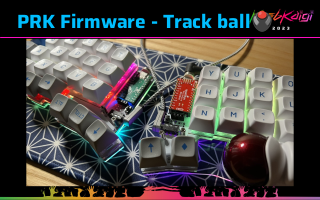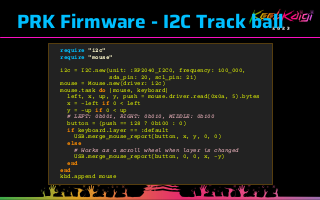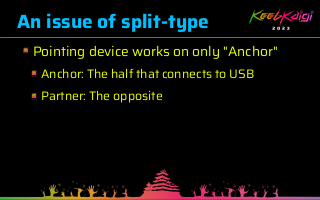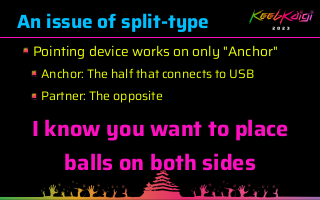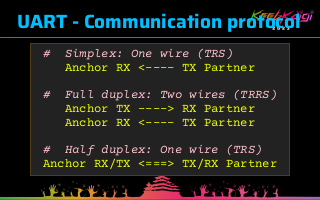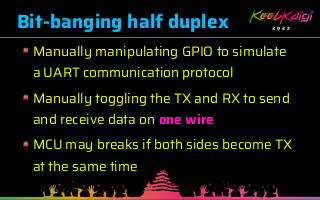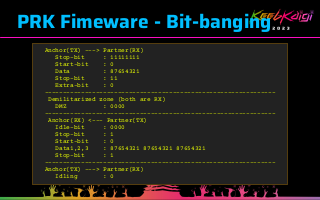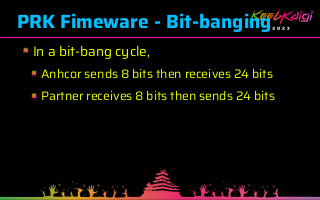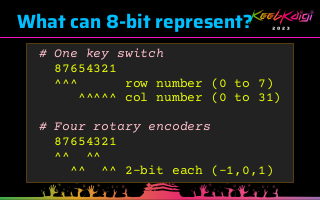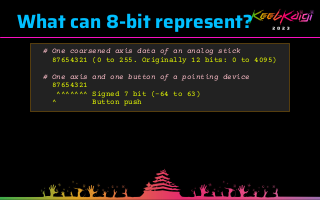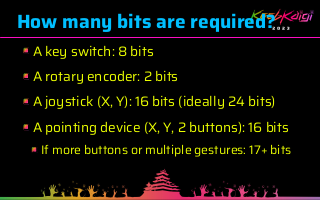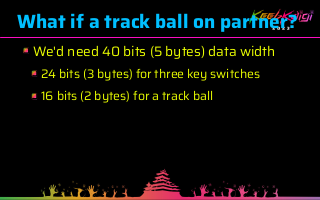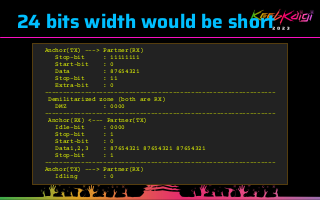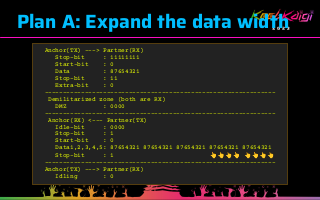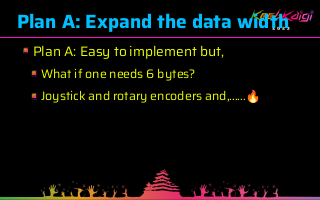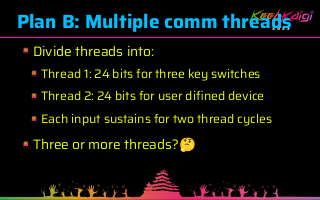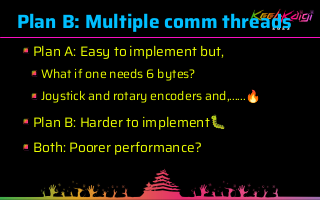Text
Page: 1
Pointing Device
On The Partner Half
hasumikin
Mar. 10, 2023
Page: 2
Today's mood
Sharing how a keybosrd firmware creator
thinks
We won't get a conclusion today
New ideas are welcome!
Page: 3
PRK Firmware - Outline
QMK inspired firmware
Written in PicoRuby
You don't need to build a firmware
Instead, just drag and drop a `keymap.rb`
Page: 4
PRK Firmware - Features
Split-type, Consumer key
Num/Caps/Scroll lock
Layer, Debounce, Composite key
Rotary encoder, Joystick
RGBLED, Sounder
Page: 5
PRK Firmware - Coming next
Track ball / Touchpad / Joystick as a
Mouse
You can configure a device based on I2C,
SPI and ADC
PicoRuby has implemented general
peripheral classes
Page: 6
PRK Firmware - Track ball
Page: 7
PRK Firmware - I2C Track ball
require "i2c"
require "mouse"
i2c = I2C.new(unit: :RP2040_I2C0, frequency: 100_000,
sda_pin: 20, scl_pin: 21)
mouse = Mouse.new(driver: i2c)
mouse.task do |mouse, keyboard|
left, x, up, y, push = mouse.driver.read(0x0a, 5).bytes
x = -left if 0 < left
y = -up if 0 < up
# LEFT: 0b001, RIGHT: 0b010, MIDDLE: 0b100
button = (push == 128 ? 0b100 : 0)
if keyboard.layer == :default
USB.merge_mouse_report(button, x, y, 0, 0)
else
# Works as a scroll wheel when layer is changed
USB.merge_mouse_report(button, 0, 0, x, -y)
end
end
kbd.append mouse
Page: 8
An issue of split-type
Pointing device works on only "Anchor"
Anchor: The half that connects to USB
Partner: The opposite
Page: 9
An issue of split-type
Pointing device works on only "Anchor"
Anchor: The half that connects to USB
Partner: The opposite
I know you want to place
balls on both sides
Page: 10
UART - Communication protocol
#Simplex: One wire (TRS)
Anchor RX <---- TX Partner
#Full duplex: Two wires (TRRS)
Anchor TX ----> RX Partner
Anchor RX <---- TX Partner
# Half duplex: One wire (TRS)
Anchor RX/TX <===> TX/RX Partner
Page: 11
Bit-banging half duplex
Manually manipulating GPIO to simulate
a UART communication protocol
Manually toggling the TX and RX to send
and receive data on one wire
MCU may breaks if both sides become TX
at the same time
Page: 12
PRK Fimeware - Bit-banging
Anchor(TX) ---> Partner(RX)
Stop-bit
: 11111111
Start-bit
: 0
Data
: 87654321
Stop-bit
: 11
Extra-bit
: 0
---------------------------------------------------------------
Demilitarized zone (both are RX)
DMZ
: 0000
---------------------------------------------------------------
Anchor(RX) <--- Partner(TX)
Idle-bit
: 0000
Stop-bit
: 1
Start-bit
: 0
Data1,2,3
: 87654321 87654321 87654321
Stop-bit
: 1
---------------------------------------------------------------
Anchor(TX) ---> Partner(RX)
Idling
: 0
Page: 13
PRK Fimeware - Bit-banging
In a bit-bang cycle,
Anhcor sends 8 bits then receives 24 bits
Partner receives 8 bits then sends 24 bits
Page: 14
What can 8-bit represent?
# One key switch
87654321
^^^
row number (0 to 7)
^^^^^ col number (0 to 31)
# Four rotary encoders
87654321
^^ ^^
^^ ^^ 2-bit each (-1,0,1)
Page: 15
What can 8-bit represent?
# One coarsened axis data of an analog stick
87654321 (0 to 255. Originally 12 bits: 0 to 4095)
# One axis and one button of a pointing device
87654321
^^^^^^^ Signed 7 bit (-64 to 63)
^
Button push
Page: 16
How many bits are required?
A key switch: 8 bits
A rotary encoder: 2 bits
A joystick (X, Y): 16 bits (ideally 24 bits)
A pointing device (X, Y, 2 buttons): 16 bits
If more buttons or multiple gestures: 17+ bits
Page: 17
What if a track ball on partner?
We'd need 40 bits (5 bytes) data width
24 bits (3 bytes) for three key switches
16 bits (2 bytes) for a track ball
Page: 18
24 bits width would be short
Anchor(TX) ---> Partner(RX)
Stop-bit
: 11111111
Start-bit
: 0
Data
: 87654321
Stop-bit
: 11
Extra-bit
: 0
---------------------------------------------------------------
Demilitarized zone (both are RX)
DMZ
: 0000
---------------------------------------------------------------
Anchor(RX) <--- Partner(TX)
Idle-bit
: 0000
Stop-bit
: 1
Start-bit
: 0
Data1,2,3
: 87654321 87654321 87654321
Stop-bit
: 1
---------------------------------------------------------------
Anchor(TX) ---> Partner(RX)
Idling
: 0
Page: 19
Plan A: Expand the data width
Anchor(TX) ---> Partner(RX)
Stop-bit
: 11111111
Start-bit
: 0
Data
: 87654321
Stop-bit
: 11
Extra-bit
: 0
---------------------------------------------------------------
Demilitarized zone (both are RX)
DMZ
: 0000
---------------------------------------------------------------
Anchor(RX) <--- Partner(TX)
Idle-bit
: 0000
Stop-bit
: 1
Start-bit
: 0
Data1,2,3,4,5: 87654321 87654321 87654321 87654321 87654321
Stop-bit
: 1
---------------------------------------------------------------
Anchor(TX) ---> Partner(RX)
Idling
: 0
Page: 20
Plan A: Expand the data width
Plan A: Easy to implement but,
What if one needs 6 bytes?
Joystick and rotary encoders and,......
Page: 21
Plan B: Multiple comm threads
Divide threads into:
Thread 1: 24 bits for three key switches
Thread 2: 24 bits for user difined device
Each input sustains for two thread cycles
Three or more threads?
Page: 22
Plan B: Multiple comm threads
Plan A: Easy to implement but,
What if one needs 6 bytes?
Joystick and rotary encoders and,......
Plan B: Harder to implement
Both: Poorer performance?
Page: 23
Plan C: ??????????????????????
If you have an idea,
reach out to
(twitter | github).com/
hasumikin


























